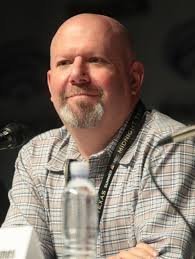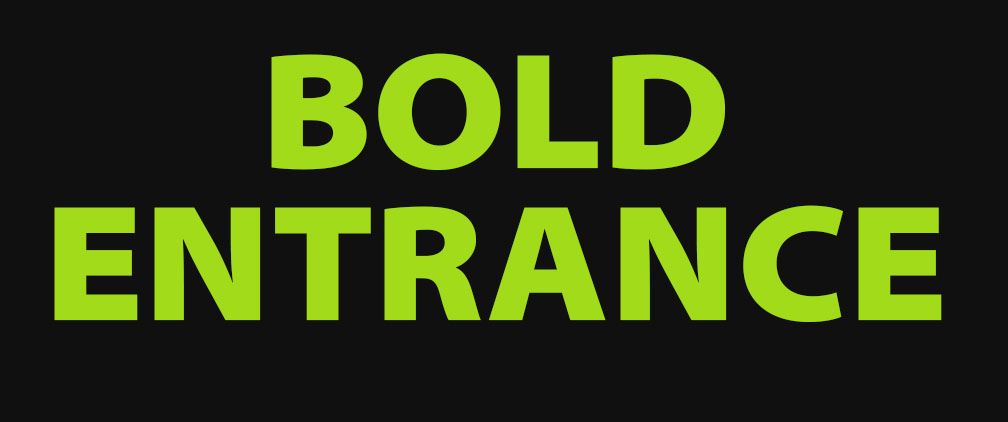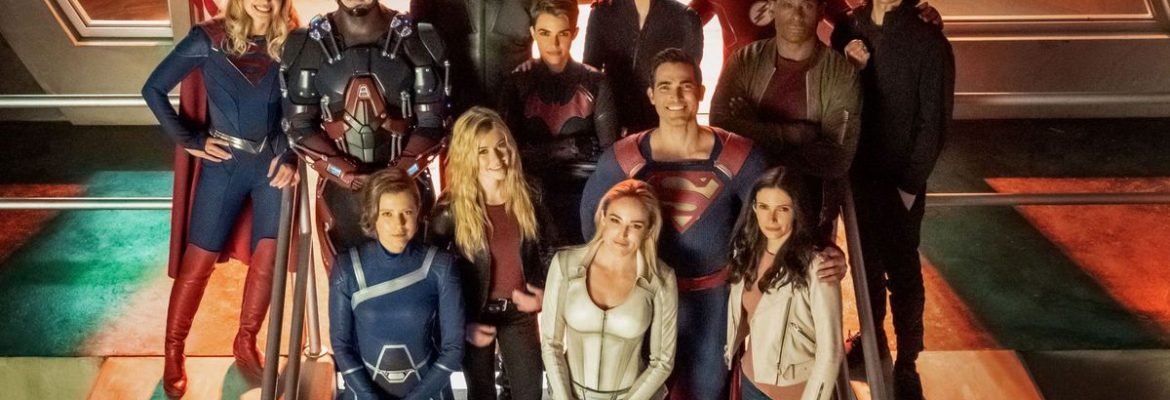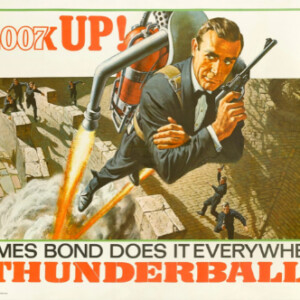How Showrunner Marc Guggenheim Developed ‘Crisis on Infinite Earths’ Across Six Shows
DC Comics epic Crisis on Infinite Earths finally gets the live-action treatment in the ‘Arrowverse’. Just how did the CW deliver the greatest crossover in television history?
The Arrowverse’s sixth crossover event is the most ambitious to date with the adaptation of one of DC Comics most epic story lines, ‘Crisis on Infinite Earths.’
DC Comics published Crisis on Infinite Earths in 1985 to help condense their various alternate realities into one shared universe for their 50th anniversary. A plethora of DC superheroes–and some villains–from the multiverse teamed up to stop the Anti-Monitor from destroying reality.
The CW’s own version of ‘Crisis’ once again unites the casts of Supergirl, Arrow, Legends of Tomorrow, Batwoman, and The Flash–and finally brings Black Lightning into the Arrowverse. In a move certain to excite DC fans, many of DC’s and Warner Brother’s movie and television properties are being untied as parts of the multiverse.
Overseeing this epic event is showrunner Marc Guggenheim, the man who works as consulting producing for the Arrowverse, and who oversees every crossover. In a series of interviews, Guggenheim gives an in-depth look at the process of bringing ‘Crisis’ to the screen from pre-production to post-production.
The Road to ‘Crisis’
Guggenheim was there from the beginning, kicking off the Arrowverse in 2012 with fellow producers Andrew Kreisberg and Greg Berlanti. Initially they had no plans to go beyond Arrow, let alone create a multiverse, but the first nods to ‘Crisis on Infinite Earths’ was there from season 1.
Lyla Michaels, one of the pivotal characters in ‘Crisis’, was introduced in episode 19 of the first season. Then The Flash introduced the multiverse, when Barry Allen traveled to Earth-2, which all seemed to make ‘Crisis’ inevitable. But as Guggenheim states, these references were nothing more than Easter eggs at the time. Many more DC characters and story lines teased over the years have, to date, gone no where.
So ‘Crisis’ remained a “long shot” for years, which Guggenheim believed was likely reserved by WB for a big budget film. Then just one and half years ago, while still in production on last year’s crossover, “Elseworlds”, the top brass at WB and DC gave Berlanti the green light to introduce ‘Crisis’ into the Arrowverse.
With ‘Crisis’ now a certainty, pre-production began immediately, with elements worked into ‘Elseworlds’. The crossover clearly worked as a prelude to ‘Crisis on Infinite Earths’ with the introduction of The Monitor, the appearance of the ominous red skies which herald the destruction of dimensions, and, of course, the announcement at the end that ‘Crisis’ would appear in Fall 2019.
The Evolution of the Crossover Event
The production of a story line as large and elaborate as ‘Crisis’ was made possible through the evolution of Arrowverse’s annual crossover. The first only featured Flash and Arrow, so the narrative was relatively straight forward. But as more shows were introduced into the Arrowverse, and audiences expected a bigger crossover than the last, the narrative needed to be freed from the narrative constraints of the shows.
The crossovers follow a simple format. Each episode works as a chapter, and each Arrowverse show will feature one of these chapters in the course of its season. This presents a potential problem. How do you produce an independent story while still fitting in with the narrative arc of each show’s season? The solution in the first three crossovers, was for each episode to focus on the core cast of the series it appeared in. For instance, the Arrow episode of 2016’s ‘Invasion!’ focused just as much on celebrating that show’s 100th episode as it did on continuing the ‘Invasion!’ story line.

But as more shows were added to the Arrowverse, this style of story telling became a limitation. Beginning with 2017’s ‘Crisis on Earth-X’, the crossover became a miniseries and put the main story line first regardless of which series the episode appeared in. For example, the double wedding of Barry and Iris, and Oliver and Felicity occurred in the Legends of Tomorrow episode.
Guggenheim would like to take it a step further:“If I controlled Hollywood, we would cut together all five hours into a single, big movie that would live on in Blu-ray. But I’ve been told repeatedly that that isn’t going to happen.”
Crafting a “Modular” Structure For ‘Crisis”
While there is more narrative freedom with ‘Crisis on Infinite Earths’, Guggenheim wanted a story structure that had “maximum flexibility,” so plot points, and scenes could be altered or swapped around after much discussion with the showrunners and writers of each show.
Guggenheim told IndieWire:
“Several months ago, I met with all the showrunners of the five shows, as well as a bunch of members of the various writing staffs, and I basically pitched them a potential structure for the crossover, where the main plot beats of each of the five hours was laid out.”
A basic “scaffold” or structure was created for the story “that we could all discuss and workaround, and something that would also be a little bit modular so that we could adapt to the creative needs of various shows,..”
Guggenheim gave them the opportunity to take advantage of this multiverse-altering story line to “fix something, or introduce a new character, or introduce a new status quo shift. and the shows embraced that.”
This story structure was fine-tuned over two weeks “coming up with a more detailed set of beats.”
With the story beats hashed out, the showrunners returned to their writing teams, who broke down “the individual episodes scene-by-scene, and [then they all] reconvened, figured out, “Okay, your beat really should belong in someone else’s episode.” “This scene in hour two really needs to happen in hour three,” and “This thing that’s happening in hour one and hour two, they contradict each other,” or they duplicate each other. Figuring out all those things.”
From there, beat sheets and synopses were distributed to the different production teams of each show. And costumes started to be made.
While costumes, and other production details were underway, the scripts were busy being written for the five episodes. The writing teams continued to meet, discuss each scene, and change things around.
“I did a pass on all the steps to make sure that various things were remaining consistent,” said Guggenheim, “and then we start basically the normal production process, and then all the pre-production process…[But] the hardest part is scheduling.”
The Difficulty in Coordinating the Cast From Six Shows
Crossovers are shot during the normal production cycles of each show, which can cause scheduling clashes required a systematic approach to scheduling. “How do you get Stephen Amell to be on two sets at once?” It’s a bit of a juggling act. Only Arrow and The Flash use the same back lot, but Supergirl, Legends, and Batwoman all shoot in Vancouver making the process a little bit easier.
To coordinate shooting schedules, assistant directors from each show sit down with color-coded schedules called call strips. Each strip represents a scene, and each show is designated a color (Arrow is green, Flash is red, Supergirl is blue, etc).
These strips are then placed on a big board, which is divided into squares, representing a calendar. Guggenheim told IndieWire:
“…[W]e basically are just moving paper around that board or moving strips from one day to another on this big calendar until all the strips are up on the board…They are an incredibly fragile thing, and the process is a little bit like doing three-dimensional chess with a Rubik’s cube. And I have to say, the ADs are incredible. They think in ways that makes the inside of my skull bleed, and in terms of what their profession is, they have to perform at an Olympic type of level to make it all happen.”
When scheduling conflicts can’t be resolved a double may stand in for the actor especially if his or her face isn’t required. With Black Lighting, the process was considerably more difficult as the show was shot 3,000 miles away in Atlanta. Initially, Guggenheim suggested a cameo, but the show’s executive producer, Salim Akil, wanted Jefferson Pierce a.k.a. Black Lightning to have a more “meaningful appearance.”
Guggenheim praised Black Lightning’s producers for making his appearance possible:
“I’ve got to give credit to Salim Akil, Charles Holland, and Lamont Magee at Black Lightning, because they really moved heaven and earth to write Cress [Williams, who plays Black Lightning] out, essentially of a week of production, which on a television show is a lot. That’s a long time. It’s like three-quarters of the episode.”
Williams was flown into Vancouver during weekends and for five days in the middle of production of ‘Crisis’.
During production, Guggenheim hopes nobody gets sick, and that the tight scheduling is minimally impacted by weather. But these things do–and have–happened. Inevitably problems cause delays on productions, especially a production as big as the Arrowverse which has been around for nearly a decade. Regardless of the issue, they all try to maintain a positive environment, and past issues have been improved:
“…[O]ne of the things I think we’ve learned over the years is not just how to schedule this so that the schedule can tell the story, but to schedule in a way that doesn’t abuse our cast. And I think over the last couple of years, it’s been a much more positive experience for the cast and for the crew.”
While Guggenheim showruns the crossovers, he respects the producers of each series. They still retain creative control on how their characters are presented in a crossover event. They do dialogue passes, review cuts, and make sure the character is depicted correctly.
Casting The Multiverse
Casting began before ‘Crisis’ was even written. Its clear Mar Novu/The Monitor was written into last year’s crossover to help set up ‘Crisis’. Guggenheim confirmed this:
“[W]e planted several creative flags in last year’s crossover, including casting LaMonica Garrett as The Monitor. In fact, we cast him basically as a series regular across all the shows so that we could do two things. So that we could feed him in multiple appearances between last year’s crossover and this year’s crossover, but also so that he could be available to us.”
For ‘Crisis’, Garrett would do double duty playing both the Monitor and the villainous Anti-Monitor.
Guggenheim then had to decide what characters to use to populate the multiverse being decimated by The Anti-Monitor. Arrowverse already had a multiverse with its own cast of characters. Some would appear in ‘Crisis’. But in addition, Guggenheim had a more exciting idea. He wanted to use characters from DC properties owned by Warner Brothers to represent the various Earths in the multiverse.
“This is ‘Crisis on Infinite Earths’, not ‘Crisis on CW Earths’,” Guggenheim told Rolling Stone. “We felt that to honor the original concept, we had to touch as many strands of the DC tapestry as possible.”
But he also had to get the go-ahead from both WB and the actors. Everyone had to agree.
“Some of them were pie-in-the-sky kind of ideas, some of them were educated guesses in terms of who we thought might want to participate. Every day was an emotional roller coaster: This person says yes, this person says no. Or, This person says yes, but we can’t afford them. There were certain characters who were approved by DC Entertainment, and then there were some where we were told absolutely not…There’s a lot of email diplomacy that goes on.”
Cameos included Curran Walters (Jason Todd/Robin) and Alan Ritchson (Hank Hall/Hawk) from Titans, Burt Ward (Dick Grayson/Robin) from Batman ’66, Robert Wuhl (Alexander Knox) from Tim Burton’s Batman, and Ashley Scott (Helena Kyle/The Huntress) from Birds of Prey who watch helplessly as the red sky destroys their various Earths.
Other characters from the multiverse had a larger part to play such as Superman and Batman. Guggenheim relished the idea of bringing in their alternate selves from parallel Earths–and some of the actors made famous playing him. Joining Tyler Hoechlin (Arrowverse’s Superman) is Superman Return’s Brandon Routh playing a ‘Kingdom Come’ version of the character, and Smallville’s Tom Welling reprising his role Clark Kent.
Although Routh already plays The Atom in the Arrowverse, Guggenheim still had to get his permission. “I had to have a creative conversation with Brandon, to see if this was something he was interested in doing. I didn’t have to twist Brandon’s arm.”
Welling also approved of his much smaller part. He liked that he wouldn’t don Superman’s cape, which was in keeping with his portrayal of Clark on Smallville. According to Guggenheim, the actor basically said they’d “‘written the one scene that I can’t say no to.'”
Guggenheim did also confirm that he did reach out to Nic Cage to play a version of Superman that the actor was meant to play in the unfilmed Tim Burton film, Superman Lives. But he turned it down.
@mguggenheim do it you coward (not really, you're awesome)! #CrisisOnInfiniteEarths pic.twitter.com/CDwcGUlFaU
— pedro type 40👽 (@OPLacerda) October 1, 2019
As for Batman, Guggenheim hired none other than Kevin Conroy, who after voicing Bruce Wayne on Batman: the Animated Series for years, finally got his chance to play a live-action version of the character. Albeit a far darker version. Guggenheim told Entertainment Weekly:
“One of the things that was always on my bucket list is that I wanted to see old Bruce Wayne. We talked about a variety of different casting possibilities, but [Legends of Tomorrow showrunner] Keto Shimizu, who is a huge animated Batman fan, pointed out that Kevin is the right age. We reached out to Kevin and he couldn’t have been more lovely and more game for it.”
Guggenheim teases there may be more actors to come in the final two episodes. Dean Cain? Teri Hatcher? Maybe even Christian Bale? Guggenheim won’t say. He’s still approaching some of them.
“I’m working on even more for the last two hours. So we’ve obviously announced a bunch, but I really want the audience to be able to tune in and still be surprised. So there are surprises of sorts that we’ve managed to keep secret, and not without great difficulty, I will tell you.”
From Post-Production to Post-Mortem
In post-production, Guggenheim and his team figure out which episodes are working and which may require reshoots, or need more VFX.
“It’s a very labor-intensive process, but every year, by hook or by crook, we somehow make it work.”
The writers and producers also get together and discuss what worked and didn’t work, and then the discussion inevitably turns to next year’s crossover.
But where do you go after a story as big as ‘Crisis on Infinite Earths’?
Guggenheim is certain next year’s won’t be as ambitious:
“I think we need to really go back to the basics.”



